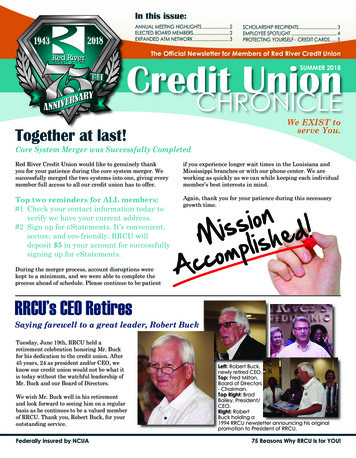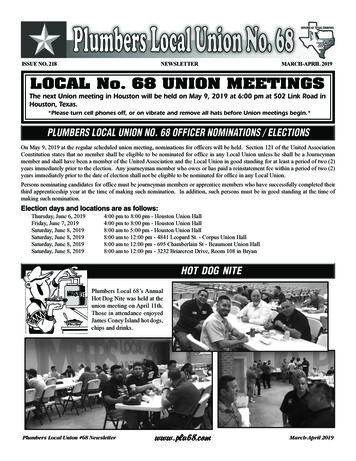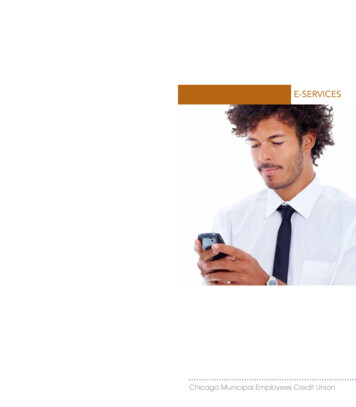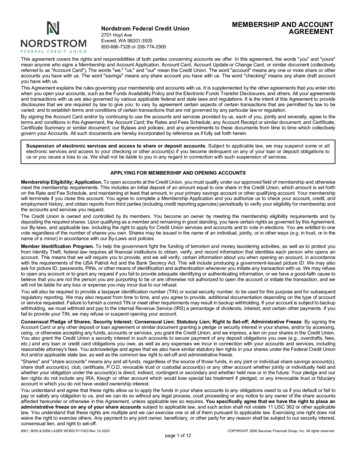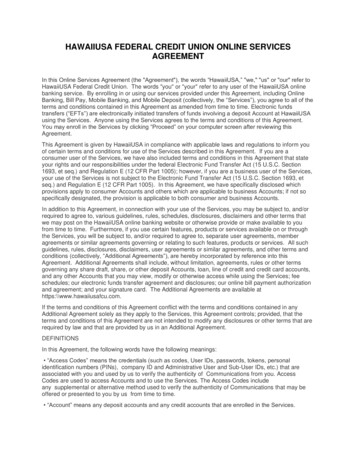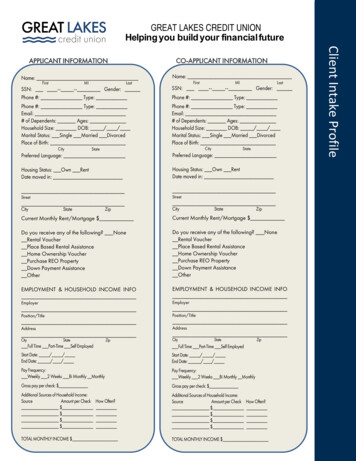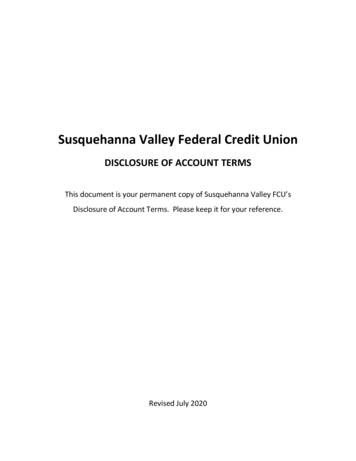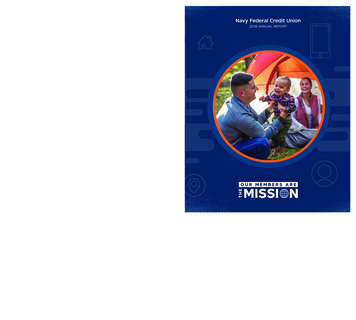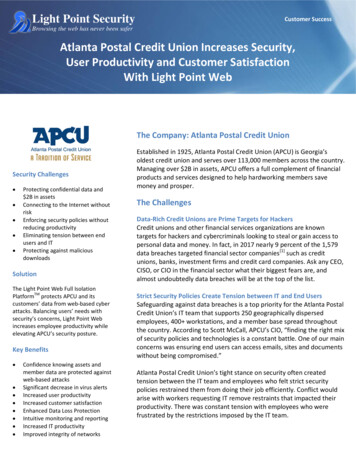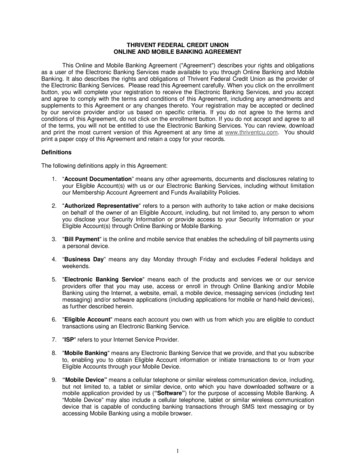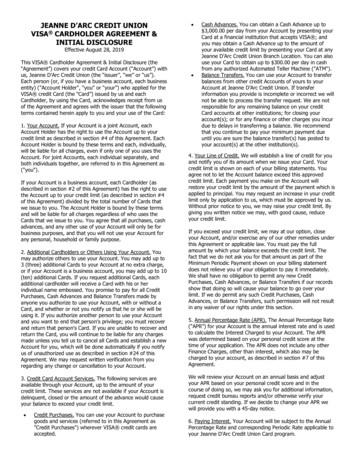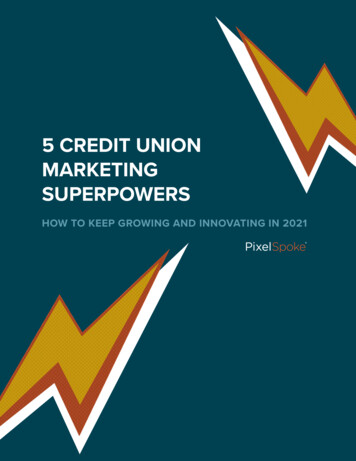
Transcription
5 CREDIT UNIONMARKETINGSUPERPOWERSHOW TO KEEP GROWING AND INNOVATING IN 20211
TABLE OF CONTENTS01Introduction502 Superpower 1: Teleportation703 Superpower 2: Collaboration1504 Superpower 3: Community Roots2105 Superpower 4: Empathy2906 Superpower 5: Inclusion3507 Conclusion4108 References433
THIS PAST YEAR HASBEEN ONE WILD RIDE.Who could have predicted COVID-19 and the myriad challenges thatwe’ll continue to navigate in the coming months and years?These challenges are, well, challenging, but they can also bring new opportunities for growth and impact. As we enter into the recovery, how do youavoid slipping back into "business as usual?" How do you seize the momentand take advantage of new opportunities for you and your members?We firmly believe the long-term health of the credit union system, and theability to meet members’ needs, demands a growth-oriented focus.So what should you do now to manage the current crisis and comeout stronger on the other side?Focusing on growth won’t always be easy — and, frankly, it might feelimpossible in the midst of all that’s currently happening. Kirk Kordeleski,who served as the CEO of Bethpage Federal Credit Union duringthree major market disruptions — 9/11, Superstorm Sandy, and theGreat Recession — shared three common reactions to a crisis ina recent Credit Union Business News article.Kordeleski argues that denial, fear, and defiance, though common reactionsto crisis, are a recipe for failure. He advocated for taking a confident,proactive approach instead.The values that are baked into the credit union difference and cooperativeprinciples can actually pave the way toward growth. They are what setcredit unions apart from other players in the financial services industry,and now is the time to make the most of them.The following five superpowers can help your credit union expand yourmembership, improve the financial health of your cooperative, and magnify the positive impact in your community — through the current turbulenceand beyond.5
SUPERPOWER #1TELEPORTATIONThe first months of the COVID-19 pandemic hammered home the importanceof good digital tools. The combination of closed branch lobbies, crowdeddrive-thrus, and a general desire to minimize social contact, drove membersof all ages to try new channels to manage their finances. In fact, a postpandemic survey conducted by Fidelity National Information Services (FIS)reported a 200% surge in mobile banking registrations in early April 2020and an 85% increase in mobile banking traffic.You might be tempted to cut your technology budget during a recession, butstudies cited in this 2019 Harvard Business Review article found there weremultiple reasons to keep investing. These included lower opportunity costs,as well as the role technology could play in helping organizations becomemore transparent, flexible, and efficient.Every credit union leader we spoke with for this ebook agreed it wasimportant to maintain digital investments in tough times. Kathy Mayer,Marketing Coordinator for Abilene Teachers FCU, reported that her creditunion focused on growing technology capacity and products throughoutthe last recession — and the credit union saw organic growth of 32.5%in assets and 31.5% in loans in part because of this investment.7
Melissa Vigil, COO at Northwest Community Credit Union, felt hercredit union kept a recession mindset longer than they should have in2007/2008. “We lingered a little bit too long this elongated somestagnation whether that was in membership growth, hiring good talent orinvesting in the digital arena. One thing we are doing differently this timeis our continued investment in digital products and services versus solelyfocusing on expense control/reduction.”The evidence suggests consumers aren’t in a hurry to return to branch lobbies,even when they can, which means prioritizing digital can be a win for bothcredit unions and members. An increased sense of urgency may be a goodthing, but it’s not without its challenges.Personal service has always been a credit union hallmark and adifferentiator that could be compromised by reducing opportunitiesfor human interaction. While digital can allow for a highly personalized,data-driven experience, there’s still something to be said for keepingthe actual person in the picture—sometimes literally!Members want digital but continue to value the personal touch.Here are five ways to deliver both:1. Include photos with your online appointmentscheduling tool.Compare the two screenshots below—one from a digitally savvyhealthcare provider called ZOOM Care (left) and one from a bank using apopular branch appointment scheduling tool. Which one does a better jobsaying “personalized, friendly service” to you? — Melissa VigilNorthwest Community Credit Union““One thing we are doing differently this timeis our continued investment in digitalproducts and services versus solelyfocusing on expense control/reduction.ZOOM Care pairs headshots with itsappointment scheduling tool (left), while apopular branch appointment schedulingtools (right) lacks a human touch.Which one does a better job saying“personalized, friendly service” to you?9
2. Turn member calls into member video chats4. Connect members to personal bankers via an appVideo chats can be a great way for members to get help with virtually anyfinancial issue without having to leave the security of their home. Plus,video chats can help reduce member frustration — Hubspot Research foundthat 33% of customers are most frustrated by having to repeat themselvesto multiple support reps over the phone, a problem that video chat canminimize. Video chat is especially valuable for members needing personalcontact and reassurance when dealing with a more complex need,like a mortgage or an investment.Umpqua, an Oregon-based community bank, was ahead of the curve whenit launched a hybrid digital-human platform, Go-To Banking, back in 2018.The app provides a list of personal bankers for the customer to choosefrom; each listing includes a photo and often-amusing self-description.Users connect with their banker of choice by pressing a button on theapp, and most communication is via text. Umpqua makes the appavailable to all customers, regardless of their net worth.According to this article in The Financial Brand, Umpqua describes the appas a valuable way to deliver “people plus technology” and reports they sawa 30% increase in enrollment and a 20% jump in customer use in March2020. This kind of tool could be a great option for tech- and text-savvymembers.3. Add a personal touch to live chatIf you’re not ready to go the full-video route, live chat can be a goodalternative. Members who are already on your site will be able to get theirquestions answered without switching to another channel (e.g., phone oremail). Add a photo to make the digital experience more personal, andconsider making your live chat proactive. With reactive chat, a memberhas to choose to engage; proactive chat is the digital equivalent of agreeter actively approaching a member as they enter the branch.Umpqua’s Go-To Banking app providesa list of personal bankers for thecustomer to choose from; each listingincludes a photo and often-amusingself-description.Image courtesy of umpquabank.com11
5. Take events virtualNothing beats the power of face-to-face annual meetings, educationalseminars, and more. But when those meetings aren’t possible, virtualoptions can be a good alternative, especially as members becomemore accustomed to and comfortable with them.Here are some examples:Clackamas CU is hosting virtual workshops—topics includeAdulting 101, Mortgages 101 and Mortgage MythBusters.Atlantic Financial held a virtual town hall to share COVID-19relief options and resources available to members.Peninsula Credit Union has been sending out video messagesfrom its CEO on an ongoing basis, with topics ranging fromfraud to re-entry plans to thanking “financial first responders.”Summit Credit Union held a virtual homebuyers’ event thathad 200 sign-ups and 125 attendees, and has futurevirtual events on its calendar.3 KEYS TO SUCCESSFUL DIGITAL TRANSFORMATIONWhether you’re launching new online loan application forms or rebuildingyour digital systems from the ground up, keep these three guiding principles in mind:Don’t digitize a cumbersome process.Focus on backend processes before you revamp the front-endtool or application.Leverage cross-functional teams.Successful transformation isn’t an IT- or marketing-only endeavor.Siloed digital transformation efforts are less successful.Our client Clackamas CU has beenhosting ongoing virtual workshopsthroughout COVID. Topics includeAdulting 101, Mortgages 101and Mortgage MythBusters.Remember your WHY.Let members’ needs drive all your digital efforts.13
SUPERPOWER #2COLLABORATIONFolks in the financial industry love to talk about innovation, usually inreference to fintech. But innovation isn’t always flashy. It doesn’t haveto involve technology, nor does it always represent a tremendousbreak-through. Sometimes innovation can be incremental.Or, as George Hofheimer, EVP of Research & Development at Filene, put it,the “coolest innovation is usually the most boring innovation.” Hofheimeralso advised that during these tenuous times, credit unions would do wellto focus less on differentiation and more on collaboration.After all, as member-owned cooperatives, collaboration is baked into thecredit union difference. From CUSOs to regional leagues and associations,credit unions routinely seek out opportunities to join forces. Collaborativepartnerships have been a driving force for innovation throughout creditunion history.Credit unions and community banks often don’t get enough credit fortheir innovations; some don’t even recognize that they are innovating.15
— George HofheimerFormer EVP of Research & Development, Filene““The biggest bang for the buck for creditunions into the future is to create a culture ofinnovation. There’s a lot of opportunity and alot of talent in the industry to help solve problems in a very, very creative way.CU Forward Day, which was first launched in 2013, became a way for themovement to bring the “why” of credit unions to life in a memorable andtangible way. It strengthened trust and connections throughout the state,and generated powerful stories to leverage in marketing efforts.Transformational DepositsHope Credit Union, which serves one of the most impoverished regions inMississippi, has launched a 100 million initiative to make more business,mortgage and consumer loans to low-income families. Not only is the creditunion partnering with Netflix, which contributed 10 million to the program,but it has launched a Transformational Deposit program to “import capital”from other (wealthier) communities.Income Advance ProgramFrom a marketing standpoint, developing new, even unexpected partnerships, can be a key to unlocking all sorts of innovative strategies that don’trequire a mobile app. Here are some examples we love:CU FORWARD DayMinnesota credit unions worked together to create a “statewide day ofkindness” (and who couldn’t use a little more of that?). The day emergedfrom three simple questions:1. How do we spread kindness?2. How can credit unions come together and do more than lobbyfor tax breaks?Can credit unions partner with businesses to help their employees be morefinancially secure, and to increase profitability for the business and thecredit union? In a word, yes. NorthCountry FCU partners with Rhino Foodsto guarantee Rhino Foods employees same-day access to 1,000 foremergency needs. The advance is repaid through payroll deductions, andwhen the loan term is complete, that auto-deduction continues to go into asavings account at the credit union.The program is a win for all involved. Over 60% of Americans don’t have 500 in savings, and finances are the biggest stress for most employees.Employees who face less financial stress are more likely to be focused andproductive. In addition to productivity gains, the business likely improvesemployee retention — and, potentially, the ability to attract new employeestoo. The credit union, meanwhile, gains new members and offers them aclear path to improved financial wellness.3. How can we grow the credit union movement and respondto the pressing challenges of our time?17
Overdraft Line of Credit for Stimulus ChecksRelief GrantsAfter Jill Castilla, CEO of Citizens Bank of Edmond, responded to a tweet byentrepreneur Mark Cuban, they ended up partnering to create an overdraftline program for the bank’s customers who were waiting for their stimuluschecks. Cuban and Castilla were able to launch the program in just a fewdays, allowing customers to overdraft their accounts by up to 900 withoutpenalty.Sometimes the best partners are your own members. Just after the onsetof COVID-19, SECU Credit Union realized that grants would be much morebeneficial to its members who were experiencing financial hardship thanloans. The credit union launched a 500 Relief Fund Grant Program, activelysoliciting contributions from members who had the means, then matchingtheir contributions. Members ultimately contributed over 53,000!Transformational Wellness ProgramIn Oregon, four credit unions, including our clients Trailhead and PointWest, have teamed up to distribute relief grants, which qualified smallbusinesses will not have to pay back. The Oregon Legislature and Governorset aside 5 million, asking these CDFIs to process the applications andissue the grants. The grants are intended for historically disadvantagedbusinesses across the state, with a focus on business owners who areBlack, Indigenous, people of color, and/or women.Allegacy FCU (a PixelSpoke client) has long focused on “wellness of mind,body, and wallet” with innovative products like the All-Health SavingsAccount. In collaboration with its local YMCA, Allegacy rewards membersfor their visits. The credit union took its commitment to wellness one(sizable) step further through a partnership with Wake Forest Baptist Health.In 2018, they launched WellQ, a preventative healthcare center that focuseson physical and financial well-being.There are foundations and philanthropists all across the country who wanthelp getting grants or low-cost loans into the hands of businesses. Theywould love to partner with a financial institution that is embedded in thelocal community and has the know-how to get the funds disbursed.Our client Allegacy Federal Credit Unionpartnered with Wake Forest Baptist Healthto launch WellQ, a preventative healthcarecenter that focuses on physical andfinancial well-being.Image courtesy of yourwellq.com19
SUPERPOWER #3COMMUNITY ROOTSLocal matters, now more than ever. A 2020 survey by ZypMedia foundconsumers were more likely to buy from a local business during theCOVID-19 crisis, with the top two reasons being a desire to support theirlocal community (84%) and a desire to support the local economy (54%).During the Great Recession, when so many of us were disillusioned withthe big banks, many credit union marketers learned that consumers wantedto keep their money in local institutions and heavily emphasized the localangle in their marketing efforts.Kathy Mayer, Marketing Coordinator for Abilene Teachers FCU, has seenthe power of local at her credit union. “[During the last recession], welearned that local consumers wanted to keep their money in local institutionsand riffed on that in our marketing efforts. Since that time, our focus hasbeen on emphasizing our local roots, our local people, and our commitmentto the community. From a marketing standpoint, I think the biggest lessonlearned was that we could play with the big boys in this market.”Here are some creative ways to highlight and celebrate your local roots:21
““[During the last recession], we learned thatlocal consumers wanted to keep theirmoney in local institutions and riffedon that in our marketing efforts. — Kathy MayerMarketing Coordinator for Abilene Teachers FCUWhen they asked people, “What do you do?” their answers didn't reflecttheir day jobs but rather their passions. For instance, someone who was aCPA by day but also loved sculpting tended to describe themselves as asculptor first and an accountant second.Recognizing the importance of art across communities, Verity invited localbands and visual artists to come up with “truth art” — artwork, in theirmedium of choice, that incorporated “Verity,” or truth, in some respect.Melina Young, who at that time served as Verity’s Director of Marketing andBrand, explained that artists weren’t asked to write or paint or draw specificallyabout the credit union, but rather taskedwith creating whatever truth meant tothem. Below are just a few examples of what participants came up with.Buy localHighlight community artistsOn the hunt for its next campaign, the marketing team at Verity CreditUnion in Seattle, Washington reached out to the community and discoveredsomething surprising:In recent months, delivering a safe-as-possible branch experience tomembers has become paramount. But instead of ordering face masks, handsanitizer, and plexiglas barriers online, can you make it a priority to partnerwith local sources? It might be a bit more time-consuming and expensive togo this route, but the quality and support are usually better, and what a greatway to walk the talk when it comes to supporting your local community!Verity Credit Union invited local bandsand visual artists to come up with “truthart” — artwork, in their medium of choice,that incorporated “Verity,” or truth, insome respect.Images courtesy of veritycu.com23
Our client Clearwater Credit Union partnered with a local seamstress toproduce nearly 500 face masks for branch employees. With so manyweddings and other events cancelled, the seamstress has seen a hugedecline in business. She told Clearwater, “You have no idea what thismeans to me.” Not only is local sourcing aligned with credit unionvalues, but it has the added benefit of giving you a story to tell.Organize a community eventRecognizing the power of outdoor festivals to connect communities,Citizens Bank of Edmond started the Heard on Hurd community festivalin Edmond. In our Remarkable Credit Union podcast, CEO Jill Castillaexplained that her bank didn’t go in with any expectation of monetarybenefit — it just saw the festival as a way to build community.But as Castilla found, when you do good, you do well. The festival was a hitwith the community — 30,000 to 40,000 people attended each year preCOVID — and also created growth opportunities for the bank. Citizensprovides ATMs at the event, builds business relationships with festivalparticipants, and co-develops technology to meet those businesses’needs. The bank has also seen a large uptick in loan transfers andnew accounts.Share local business storiesWe all know the power of storytelling. It’s a wonderful way to inspireempathy while bringing visibility to an important issue or cause. Nowis the time to share the stories of your local businesses, whether theyare members of your credit union or favorite lunch spots for your branchemployees. Our clients OnPoint, and Clearwater both do a great job ofhighlighting and celebrating local businesses on their blog and in theirsocial media channels.Credit unions can go a step beyond visibility and offer incentives formembers to buy from local businesses. At the beginning of COVID,for example, our client Baton Rouge Telco launched #OperationTakeout,encouraging members to get takeout from featured restaurants for achance to win a gift certificate.Our clients OnPoint and Clearwater bothdo a great job of highlighting andcelebrating local businesses on theirblog and in their social media channels.But Castilla cautioned, “If we had just said we were going to do this eventso we could get ten million dollars in loans, we would’ve lost all that magic.We may have gotten close to that goal, or maybe e
Mar 05, 2021 · when the loan term is complete, that auto-deduction continues to go into a savings account at the credit union. The program is a win for all involved. Over 60% of Americans don’t have 500 in savings, and finances are the biggest stress for most employees. Employees who face less finan
